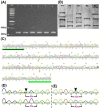Polymorphisms of the PRLR Gene and Their Association with Milk Production Traits in Egyptian Buffaloes
- PMID: 33923003
- PMCID: PMC8146870
- DOI: 10.3390/ani11051237
Polymorphisms of the PRLR Gene and Their Association with Milk Production Traits in Egyptian Buffaloes
Abstract
Prolactin (PRL) and its receptor (PRLR) were considered as potential genetic markers for milk production and quality traits in cattle. However, little information is available regarding PRLR genetic diversity and association studies with milk traits in Egyptian water buffaloes. Therefore, the present study was conducted to search for mutations in PRLR and determine their associations with milk performance in these animals. Exon3 (E3) and E10 of PRLR were screened for polymorphisms using single strand conformation polymorphism (SSCP) and sequencing in 400 buffaloes. The associations between haplotypes and milk production (fat%, protein%, lactose%, and solid%) traits as well as mRNA and protein levels of PRL and PRLR were studied. Two single nucleotide polymorphisms (SNPs) in E10 were detected: g.11685G>A (p.Ala494Thr) and g.11773T>C (p.Val523Aal). The G and T alleles were wild (ancestral) alleles, while the A and C alleles were mutant alleles. These SNPs resulted in four haplotypes; AC, AT, GC, and GT. Buffaloes with wild GT haplotypes showed significantly higher milk yield, fat% and protein%, mRNA and protein levels of PRL and PRLR in milk somatic cells than other animals. Animals carrying mutant AC haplotype had inferior milk traits and lowest levels of associated mRNAs and proteins. With these results, we could conclude that the selection of buffaloes with wild GT haplotypes for g.11685G>A and g.11773T>C SNPs of the PRLR gene might improve the milk production traits of Egyptian water buffaloes.
Keywords: Egyptian buffalo; milk performance; mutations; prolactin receptor.
Conflict of interest statement
The authors declare that there is no conflict of interest.
Figures



Similar articles
-
Association of Genes TRH, PRL and PRLR with Milk Performance, Reproductive Traits and Heat Stress Response in Dairy Cattle.Int J Mol Sci. 2025 Feb 24;26(5):1963. doi: 10.3390/ijms26051963. Int J Mol Sci. 2025. PMID: 40076589 Free PMC article.
-
Association of GHR Polymorphisms with Milk Production in Buffaloes.Animals (Basel). 2020 Jul 15;10(7):1203. doi: 10.3390/ani10071203. Animals (Basel). 2020. PMID: 32679878 Free PMC article.
-
DGAT1, GH, GHR, PRL and PRLR polymorphism in water buffalo (Bubalus bubalis).Reprod Domest Anim. 2012 Apr;47(2):328-34. doi: 10.1111/j.1439-0531.2011.01876.x. Epub 2011 Aug 30. Reprod Domest Anim. 2012. PMID: 21883511
-
Remarkable genetic diversity detected at river buffalo prolactin receptor (PRLR) gene and association studies with milk fatty acid composition.Anim Genet. 2018 Jun;49(3):159-168. doi: 10.1111/age.12645. Epub 2018 Mar 23. Anim Genet. 2018. PMID: 29569734
-
Prolactin (PRL) and prolactin receptor (PRLR) genes and their role in poultry production traits.Folia Biol (Krakow). 2014;62(1):1-8. doi: 10.3409/fb62_1.1. Folia Biol (Krakow). 2014. PMID: 24745142 Review.
Cited by
-
ABCD4 is associated with mammary gland development in mammals.BMC Genomics. 2024 May 20;25(1):494. doi: 10.1186/s12864-024-10398-9. BMC Genomics. 2024. PMID: 38764031 Free PMC article.
-
Association of Genes TRH, PRL and PRLR with Milk Performance, Reproductive Traits and Heat Stress Response in Dairy Cattle.Int J Mol Sci. 2025 Feb 24;26(5):1963. doi: 10.3390/ijms26051963. Int J Mol Sci. 2025. PMID: 40076589 Free PMC article.
-
Identification and Validation of Genus/Species-Specific Short InDels in Dairy Ruminants.BMC Vet Res. 2025 Mar 28;21(1):215. doi: 10.1186/s12917-025-04694-z. BMC Vet Res. 2025. PMID: 40155939 Free PMC article.
-
A transcriptomic analysis of skeletal muscle tissues reveals promising candidate genes and pathways accountable for different daily weight gain in Hanwoo cattle.Sci Rep. 2024 Jan 3;14(1):315. doi: 10.1038/s41598-023-51037-9. Sci Rep. 2024. PMID: 38172605 Free PMC article.
-
Association of Silent Variant p.17Pro = SNP in the LHX4 Gene with Litter Size in Awassi Sheep.Biochem Genet. 2025 Aug 9. doi: 10.1007/s10528-025-11223-y. Online ahead of print. Biochem Genet. 2025. PMID: 40782137
References
-
- Krovvidi S., Panneerselvam S., Thiruvenkadan A.K., Abraham J., Vinodkumar G. Factors effecting milk composition of crossbred dairy cattle in southern india. Int. J. Food Agric. Vet. Sci. 2013;3:229–232.
Grants and funding
LinkOut - more resources
Full Text Sources
Miscellaneous

